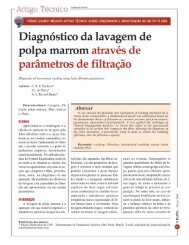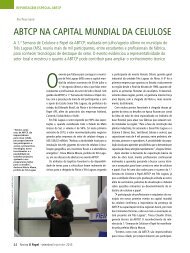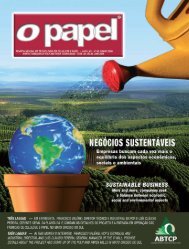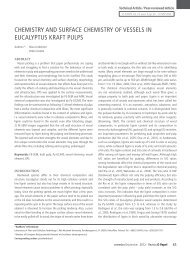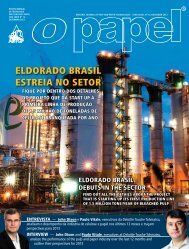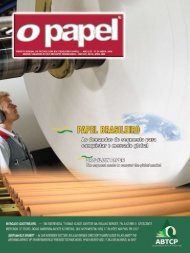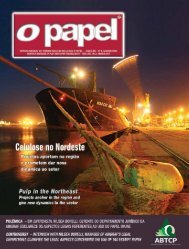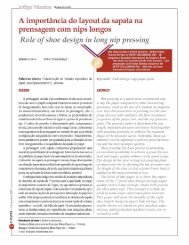Brasil na PulPaper - Revista O Papel
Brasil na PulPaper - Revista O Papel
Brasil na PulPaper - Revista O Papel
You also want an ePaper? Increase the reach of your titles
YUMPU automatically turns print PDFs into web optimized ePapers that Google loves.
O PAPEL vol. 71, num. 6, pp. 57 - 71 JUN 2010O PAPEL - Junho 201066interno do depósito exterior -, é normalmente estimada emcerca de 30º-50ºC acima da temperatura local do vapor (ouágua) para superaquecedores expostos a radiação direta ecerca de 10ºC-20ºC acima da temperatura local do vapor (ouágua) para superaquecedores protegidos da radiação direta(por exemplo: atrás do <strong>na</strong>riz). Isso é devido ao gradientetérmico através do tubo causado pela diferença de temperaturaentre o vapor e o fluxo de gás. Consequentemente, atemperatura média da superfície do metal do tubo <strong>na</strong> saídado superaquecedor pode ser tão alta quanto 530ºC ou 550ºCse a temperatura do vapor for 480ºC ou 500ºC.Em um estudo de caso (Hiner et al., 2000), depois da instalaçãode precipitadores de alta eficiência em duas fábricas,a maior captura de cloretos de sódio e potássio aumentou asquantidades de cloretos reintroduzidos no licor mediante areciclagem da cinza. As duas unidades incorreram em maiorfrequência de lavagens, menor disponibilidade e rápidadeterioração das temperaturas do vapor superaquecido. Emconsequência, as temperaturas de saída do vapor precisaramser reduzidas de 482ºC para 468ºC a fim de reduzir as taxasde corrosão no superaquecedor secundário. Há também apossibilidade de a queima de licor com teor de sólidos maisalto ter diminuído as emissões anteriores de cloreto comoHCl, o que levou a aumento de Cl no ciclo do licor.Skrifvars et al. (2008), após testes de laboratório commaterial de superaquecedor, apresentaram dois novos termosà comunidade da corrosão: corrosão sub-T 0, indicando acorrosão que ocorre abaixo de qualquer fusão do depósito ecorrosão super-T 0, indicando corrosão que acontece quando odepósito contém fundido. Todos sabemos que a corrosão aumentacom temperatura acima da faixa de fusão do depósitodo superaquecedor. Contudo, os pesquisadores concluíramque corrosão poderia também acontecer a temperaturas claramenteabaixo de qualquer fusão do sal dos depósitos, nocaso de haver presença de cloro no sal. Isso significa que apurga de cloro e potássio do ciclo de recuperações químicasem uma fábrica de celulose kraft deve ser muito eficientepara que se abram possibilidades a aumento de temperaturasdo vapor. Alguns pesquisadores, como Jaretun e Aly (2000)e Minday et al. (1997), estudaram a remoção de cloreto epotássio do ciclo de recuperação kraft.Keiser et al. (2007) realizaram algumas experiênciascom a criação, em laboratório, de um “pior caso” de depósitosintético em superaquecedor, com T 0ao redor dos 525ºC. Oobjetivo era avaliar a aptidão de ligas metálicas. Foi constatadoque a corrosividade do depósito sintético era intensificadasignificativamente <strong>na</strong> presença de mistura de gás reativo.Ocorreu efeito danoso de enxofre e oxigênio em combi<strong>na</strong>çãocom cloro. Os resultados não foram de todo consistentesinter<strong>na</strong>l side of the exter<strong>na</strong>l deposit -, is usually estimatedto be around 30ºC-50°C above the local steam(or water) temperature for superheaters that see directradiation and around 10ºC-20°C above the local steam(or water) temperature for superheaters that are shieldedfrom direct radiation (e.g. behind nose). This is due tothe thermal gradient through the tube caused by the temperaturedifference between the steam and the flue gases.Consequently, the mean surface temperature of the tubemetal at the superheater outlet can be as high as 530°Cor 550°C if the steam temperature is 480°C or 500°C.In a study case (Hiner et al., 2000), after installationof high efficiency precipitators in two mills,the higher capture of sodium and potassium chlorideincreased the amounts of chlorides that are re-introducedinto the liquor via ash recycling. Both unitsexperienced increased water wash frequency, reducedavailability, and rapid degradation of superheatedsteam temperatures. Subsequently, steam outlet temperatureshad to be reduced from 482ºC to 468ºCto decrease corrosion rates in the secondary superheater.There is also the possibility that higher solidfiring decreased the previous emissions of chloride asHCl, which led to increase of Cl in the liquor cycle.Skrifvars et al. (2008), after laboratory tests withsuperheater material, introduced two new terms to thecorrosion community: sub-T 0corrosion, indicatingcorrosion taking place below any melting of the depositand super-T 0corrosion, indicating corrosion takingplace when the deposit contains melt. We all know thatcorrosion increases at temperature above the superheaterdeposit melting range. However, they concludedthat corrosion could take place also at temperaturesclearly below any melting of the salt deposits, whenchlorine was present in the salt. It implies that purgingof chlorine and potassium from the chemicals recoverycycle of a kraft pulp mill needs to be very efficient toopen the possibilities for increased steam temperatures.Some researchers like Jaretun and Aly (2000)and Minday et al., (1997) studied the removal of chlorideand potassium from the kraft recovery cycle.Keiser et al. (2007) have performed some experimentsby creating, in laboratory, a “worst case” synthetic superheaterdeposit, with T 0around 525ºC. The target wasto evaluate alloy suitability. It was noticed that corrosivityof the synthetic deposit was significantly enhancedin the presence of the reactive gas mixture. There was adetrimental influence of sulfur and oxygen, in combi<strong>na</strong>tionwith chlorine. The results were not totally consistent



